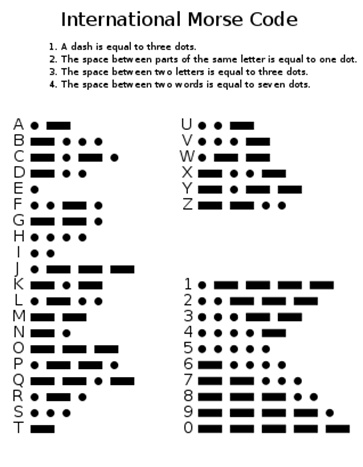You’d normally associate English with communication but maths has an almost equally important role to play. This series of activities introduce children to codes and communication.
Activity One – Sequences and codes
LO: To be able to recognise simple number patterns and sequences
To be able to identify the next term in a sequence and state the progression
The simplest sequence is counting on in ones which we do from an early age but what is tricky in those tender years is to recognise the relevance of the name of the number to what it actually signifies. It’s learning a new language where a group of five objects is named by the word ‘five’. Sequences gradually get more difficult, from counting in 2s, 3s and so on to ones where it’s squares of numbers or cubes or where the next term is algebraically calculated.
The easiest way to identify the progression of a sequence is to calculate the difference between the terms.
Show the children this example:
0, 1, 3, 6, 10, 15 and ask them to tell you the progression
They should identify that it goes up by 1 then 2 then 3 etc.
This is a sequence of triangle numbers but they don’t need to know that to be able to work out that the next two terms will be 21 and 28.
Try these with them, asking them to identify the progression then the next two terms.
a) 1, 3 ,7, 13, 21, 31
b) 2, 4, 7, 9, 12, 14, 17, 19
c) 0,1, 1, 2, 3, 5, 8, 13, 21, (a tricky one)
Codes are an interesting use of number, especially if you match the alphabet with the numbers 1 to 26. This is a simple code but allows the children to begin to understand the principle. Use it to get them to write their names in code and use the cipher to work out whose name is which.
Talking Point: The idea of a code is that it’s a secret between people who want to share messages without others knowing. The simple code we’ve just looked at makes it easy for others to intercept messages. How could we make it more difficult?
The children should suggest changing the numbers that go with the letters either randomly, in which case the recipient would need the cipher or progressively by making A be 4 and B be 5 for example.
Ask the children to change the original code progressively and see now if anyone can decode the names.
At Home: Devise your own code and write a message using it for the teacher to decipher!
Activity Two – Base Numbers
LO: Understand that although our number system is effectively metric, you don’t have to count in hundreds, tens and units
Understand how base 2 numbers (binary) can be used to express numbers
Base numbers dropped out of the primary curriculum a long time ago but may be making a comeback! Whilst many are of little use except in codes, binary code; using 1 and 0 to represent numbers, is used in computing across the globe and is fun to work with.
Write these numbers on the board:
1 = 1
10 = 2
11 = 3
100 = 4
101 = 5
110 = 6
111= 7
Talking point: Ask the children if they can work out how the numbers match. If they struggle place the numbers in places with the place value headings as question marks. This will help them to consider what value each digit might be.
Once they have realised that the place value headings are 4s, 2s and 1s, ask them to rewrite a selection of base 10 numbers up to a hundred, predicting what the extending place value headings might be.
They should notice that whereas in base 10 the numbers in each place holder can only go up to 9 before beginning again and adding a digit to the next column, in binary (base 2) it can only go up to 1.
Extension or At Home: Numbers can operate from any base so ask them to write out the numbers 1 – 10 using base 3. You should get the response:
1, 2, 10, 11, 12, 20, 21, 22, 100, 101
Activity Three – Morse Code
LO: Understand how binary numbers can be expressed by a series of on/off commands or short or long pulses
Understand how Morse code uses a binary system to convey messages
Morse code was one of the best inventions in the field of communications – a quick and simple way to communicate using dots and dashes. You’ll notice that Morse code is almost a binary system with dots and dashes representing the 1s and 0s. A dot was a quick pulse on a transmitter whilst the dash was a longer one.
A great activity for the children to do which involves translating Morse code into binary and then base ten numbers giving an excellent code that they can use between themselves.
The Morse code alphabet is as follows:
Taking the letter A for example, if a dot is a 0 and a dash a 1 then A would be 1 in binary and base 10, B – dash, followed by three dots would become 1000 in base 2 and 8 in base ten. C would be 1010 in binary and so 10 in base 10, D would be 100 and so a 4, and so on.
The code for ‘dad’ would be 4, 1, 4 and for ‘cab’ would be 10, 1, 8
Ask the children to continue working out the letters of the alphabet. There are one or two which duplicate so can they suggest a way around it?
At Home: Ask the children to use their code to write a message to a friend.
Dave Lewis – Primary Teacher
Take a look at Collins Big Cat: Code Making, Code Breaking




